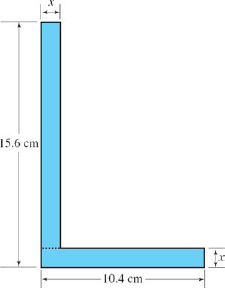12.3. Applications
Now that we have the tools to solve any quadratic, let us go on to problems from technology that require us to solve these equations. At this point you might want to take a quick look at Chap. 3 and review some of the suggestions for setting up and solving applications problems. You should set up these problems just as you did then.
When you solve the resulting quadratic, you will usually get two roots. If one of the roots does not make sense in the physical problem (such as a beam having a length of −2000 ft), throw it away. But do not be too hasty. Often a second root will give an unexpected but valid answer.
Figure 12.4. FIGURE 12-4

Example 12:The angle iron in Fig. 12-4 has a cross-sectional area of 53.4 cm2. Find the thickness x. Estimate: Let's assume that we have two rectangles of width x, with lengths of 15.6 cm and 10.4 cm. Setting their combined area equal to 53.4 cm2 gives
Thus we get the approximation x ≈ 2.05 cm. But since our assumed lengths were too great, because we have counted the small square in the corner twice, our estimated value of x must be too small. We thus conclude that x > 2.05 cm. Solution: We divide the area into two rectangles, as shown by the dashed line at the bottom of Fig. 12-4. One rectangle has an area of 10.4x, and the other has an area of (15.6 − x)x. Since the sum of these areas must be 53.4, |
Get Technical Mathematics, Sixth Edition now with the O’Reilly learning platform.
O’Reilly members experience books, live events, courses curated by job role, and more from O’Reilly and nearly 200 top publishers.

